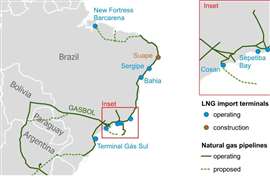Pennsylvania Set Gas Record In 2018
July 10, 2019

After looking through the just-released annual oil and gas report from the Pennsylvania Dept. of Environmental Protection (DEP), one fact is clear: though they are separated by about 1600 miles, different climates and even by accents, Texas and Pennsylvania have something in common besides being hotbeds of high school football. Both produce a whole lot of natural gas, with most of it coming from unconventional sources.
According to the 2018 Oil and Gas Annual Report, Pennsylvania produced approximately 6.1 trillion cu.ft. of natural gas from unconventional gas wells last year. That was the most gas produced in a single year ever in the Keystone State, and placed Pennsylvania second in the nation behind Texas, which developed more than 7.2 trillion cu. ft. in 2018.
Oil and gas operators drilled a total of 917 oil and gas wells in Pennsylvania in 2018. That total included 689 unconventional gas wells drilled into the Marcellus shale play and 66 unconventional natural gas wells drilled into the Utica and Point Pleasant formations. Twenty-two unconventional wells were drilled in other formations, along with 140 conventional oil wells.
“DEP attained new levels of efficiency in the permit application and review process as well as site inspections in 2018 and we continue to seek new avenues to improve customer service and environmental protection,” said DEP Secretary Patrick McDonnell. “Governor Wolf and DEP have made permitting and inspection efficiency a priority – reducing overall permit backlog by more than 90% since 2016, and improving inspection efficiency while ensuring compliance with our environmental regulations.”
The report noted that DEP personnel completed 36,873 compliance inspections at conventional and unconventional well sites last year, about 585 more than in 2017. The surface activities inspection process moved to tablet computers, making it more efficient and getting the results to operators and the public faster. All inspections are now done electronically.
The year also brought advancements in permitting. DEP launched an updated Erosion and Sediment Control General Permit, ESCGP-3, in electronic format and provided extensive training to industry on both the new requirements and the electronic application.
By the end of the year, average review time for the ESCGP had dropped to 157 days in the southwest and 85 days in the rest of the state. The average time to review well-drilling permit applications shortened to about 39 days statewide. Across DEP permit backlog has been reduced from more than 8700 in early 2016 to just 635 in June 2019, the agency said.
As a result of the oil and gas drilling booms during the mid-19th and early 20th centuries, thousands of oil and gas wells were drilled in the state and over the past 150 years, many wells were abandoned by their owners without notifying DEP or other state agencies. DEP said it has located 12,164 orphan and abandoned wells – 8752 unplugged wells and 3412 plugged – and the agency said it is working to identify the location of the many remaining wells.
Overall, DEP estimated there are about 200,000 abandoned oil and gas wells in Pennsylvania that remain unaccounted for. The agency said that given its current resources, it will likely take it many years to locate and properly decommission all of the existing legacy wells.
To view the complete DEP report, click here.
MAGAZINE
NEWSLETTER

CONNECT WITH THE TEAM








